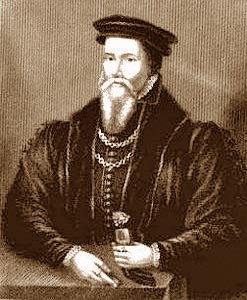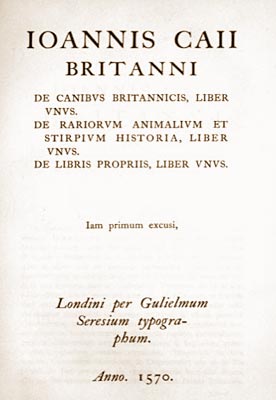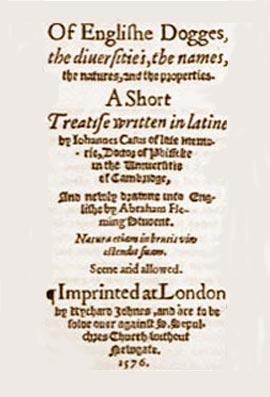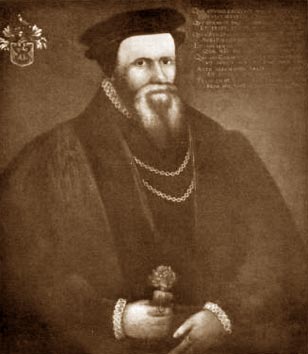

![]()
JOHANNES CAIUS
1510-1573


 Johannes Caius, was born John Keys in Norwich, England. He became a student at what was then Gonville Hall (and is now called Gonville and Caius College), Cambridge, where he studied the humanities and possibly divinity, graduating in 1533. It was while he was at Gonville that he Latinized the spelling of his name to Caius. After graduating, he visited Italy, studying there at Padua, where he took his degree in "physic" (medicine) in 1541 before returning to England and setting up practice in London.
Johannes Caius, was born John Keys in Norwich, England. He became a student at what was then Gonville Hall (and is now called Gonville and Caius College), Cambridge, where he studied the humanities and possibly divinity, graduating in 1533. It was while he was at Gonville that he Latinized the spelling of his name to Caius. After graduating, he visited Italy, studying there at Padua, where he took his degree in "physic" (medicine) in 1541 before returning to England and setting up practice in London.
At one time the physician to Edward VI, Queen Mary, and Queen Elizabeth I, Caius is also reputed to have been the doctor that Shakespeare based his eccentric Dr. Caius on in the Merry Wives of Windsor. Caius is perhaps best known as a pioneer in medicine, but those of us interested in sheepdog history know him as the man who wrote the first dissertation on British dogs, in which there is a description of the shepherd's dog that we can recognize today.
De Canibus Britannicis (The Dogs of Britain) was written in Latin (above, left) in 1570, and in 1576 translated it into English (above, right) by Abraham Fleming under the name Of Englishe Dogges, the Diversities, the Names, the Natures, and the Properties: A Short Treatise. We know it today as A Treatise on Englishe Dogges. The fourth section contains the discussion of shepherds' dogs:

OF ENGLISHE DOGGES
The fourth Section of this discourse
Dogges of a course kind serving for many necessary
uses called in Latine Canes rustici, and first of
the shepherds dogge called in Latine
Canis Pastoralis.
...Our shepherdes dogge is not huge, vaste, and bigge, but of an indifferent stature and growth, because it has not to deale with the bloudthyrsty wolf, sythence there be none in England...This dogge either at the hearing of his masters voyce, or at the wagging and whisteling in his fist, or at his shrill and horse hissing bringeth the wandring weathers and straying sheepe, into the selfe same place where his masters will and wishe is to have the[m], wherby the shepherd repeth this benefite, namely, that with litle labour and no toyle or moving of his feete he may rule and guide his flocke, according to his owne desire, backward, or to turne this way, or to take that way. For it is not in Englande, as it is in Fraunce, [etc.] where the sheepe follow the shepherd, for heere in our country the sheepherd followeth the sheepe. And somtimes the straying sheepe, when no dogge runneth before them, nor goeth about & beside them, gather themselves together in a flocke, when they heere the sheepherd whistle in his fist, for feare of the Dogge...remembring...that the Dogge commonly runneth out at his masters warrant which is his whistle. This have we oftentimes diligently marcked in taking our journey from towne to towne, when wee have hard a sheepherd whistle we have rayned in our horse and stoode styll a space to see the proofe and triall of this matter. Furthermore with this dogge doth the sheepherd take sheepe for ye slaughter, and to be healed if they be sicke, no hurt or harme in the world done to the simple creature.
We assume that by "course kind" Caius meant that they were not bred for looks but for their utility. There is an implication in this text that the same dog that was used for field and hill work was also used as a droving dog. There is also a hint of the possibility of veterinarians practicing in the day, though it is more likely that Caius meant that the dog brought the sheep into the fold for healing by the shepherd. This and other questions will have to be pursued further.
It is a bit curious that Caius was so interested in dogs, being a human doctor, but in truth, he was asked by fellow scholar and physician, Conrad Gesner of Zurich (1516-1565), to write this Treatise as an addition to Gesner's own monumental work on natural history, History of Animals, which included "Beastes, Byrdes, and Fyshes, the sundry shapes of plantes, and the fashions of Hearbes, &c". In Caius' introduction, he points out that Gesner only mentioned "Scottishe Dogges" briefly and "Englishe Dogges" not at all. However, by the time Caius wrote his Treatise (1570), Gesner was already dead, and so the Treatise on Englishe Dogges stood on it's own.
Copyright 2008 by Carole L. Presberg
THE OTHER WEB PAGES WE MAINTAIN
These web pages are copyright ©2013
and maintained by webmeistress Carole Presberg
with technical help from webwizard David Presberg
ALL RIGHTS RESERVED
If you are interested in using ANY material on this website, you MUST first ask for permission.
You may email us at carole@woolgather.org.